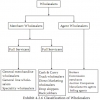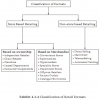MARKETING MANAGEMENT - PROMOTION DECISION
The communication process - Marketing Communication
Posted On :
In a communication process there are two parties –Sender and Receiver and two communication tools –Message and Media.
The communication process
sender: The party who is sending the message
Encoding: The process of putting the message in to symbolic form
Message: The set of symbols that the sender transmits
Media: The communication channel through which the message moves from sender to receiver
Receiver: The party receiving the message sent by the sender
Response: The reaction of the receiver
after being exposed to the message
Feedback:The part of the receiver’s response communicated back to the sender.
Noise: The unplanned distortion during communication process
A. Identify the target audience
1. Image analysis is a major part of audience analysis that entails assessing the audience’s current image of the company, its products, and its competitors
a) First step is to measure target audience’s knowledge of the subject using a familiarity scale
b) Second step is to determine feelings toward the product using a favorability scale
2. Specific content of a product’s image is best determined with use of semantic differential (relevant dimensions, reducing set of relevant dimensions, administering to a
sample, averaging the results, checking on the image variance)
B. Determine the communication objectives
1. Based on seeking of a cognitive, affective, or behavioral response
2. Assuming the buyer has high involvement with the product
category and perceives high differentiation within the category, base objectives on the hierarchy-of-effects model (hierarchy: awareness, knowledge, liking, preference, conviction, purchase)
C. Design the message (AIDA model)
In a communication process there
are two parties –Sender and Receiver and two communication tools –Message and
Media. In the communication process four functions are involved –Encoding,
Decoding, Response and Feedback. Besides these there is noise.


sender: The party who is sending the message
Encoding: The process of putting the message in to symbolic form
Message: The set of symbols that the sender transmits
Media: The communication channel through which the message moves from sender to receiver
Receiver: The party receiving the message sent by the sender
Feedback:The part of the receiver’s response communicated back to the sender.
Noise: The unplanned distortion during communication process
Developing effective communications
A. Identify the target audience
1. Image analysis is a major part of audience analysis that entails assessing the audience’s current image of the company, its products, and its competitors
a) First step is to measure target audience’s knowledge of the subject using a familiarity scale
b) Second step is to determine feelings toward the product using a favorability scale
2. Specific content of a product’s image is best determined with use of semantic differential (relevant dimensions, reducing set of relevant dimensions, administering to a
sample, averaging the results, checking on the image variance)
B. Determine the communication objectives
1. Based on seeking of a cognitive, affective, or behavioral response
2. Assuming the buyer has high involvement with the product
category and perceives high differentiation within the category, base objectives on the hierarchy-of-effects model (hierarchy: awareness, knowledge, liking, preference, conviction, purchase)
C. Design the message (AIDA model)
1. Message content—choosing an appeal (rational appeal to audience’s self interest, emotional appeal attempt to stir up either positive or negative emotions, moral appeals are directed to the audience’s sense of what is right and proper)
2. Message structure—one-sided presentation versus two-sided argument.
3.
Message format—must be strong,
based on headline, copy, “sound,” nonverbal clues, color, expression, dress,
etc.
4. Message source —expertise, trustworthiness and liability
D. Select the communication channels
1. Personal communication channels—direct (advocate, expert and social)
2. Non-personal communication channels—indirect (media, atmospheres, events)
E. Establish the total marketing communications budget
1. Affordable method
2. Percentage-of-sales method
3. Competitive-parity method
4. Objective-and-task method
Deciding on the marketing communications mix
F. Promotional tools—benefits of each tool (advertising, sales promotion, public relations and publicity, personal selling, direct marketing)
G. Factors in setting the marketing communications mix (type of product market, buyer-readiness stage, product-life-cycle stage)
H. Measure the communications’ results Managing the integrated marketing communications process
A. A concept of marketing communications planning that recognizes the added value of a comprehensive plan
1. Evaluates the strategic roles of a variety of communications disciplines
2. Combines these disciplines to provide clarity, consistency and
4. Message source —expertise, trustworthiness and liability
D. Select the communication channels
1. Personal communication channels—direct (advocate, expert and social)
2. Non-personal communication channels—indirect (media, atmospheres, events)
E. Establish the total marketing communications budget
1. Affordable method
2. Percentage-of-sales method
3. Competitive-parity method
4. Objective-and-task method
Deciding on the marketing communications mix
F. Promotional tools—benefits of each tool (advertising, sales promotion, public relations and publicity, personal selling, direct marketing)
G. Factors in setting the marketing communications mix (type of product market, buyer-readiness stage, product-life-cycle stage)
H. Measure the communications’ results Managing the integrated marketing communications process
A. A concept of marketing communications planning that recognizes the added value of a comprehensive plan
1. Evaluates the strategic roles of a variety of communications disciplines
2. Combines these disciplines to provide clarity, consistency and
Tags : MARKETING MANAGEMENT - PROMOTION DECISION
Last 30 days 483 views
















